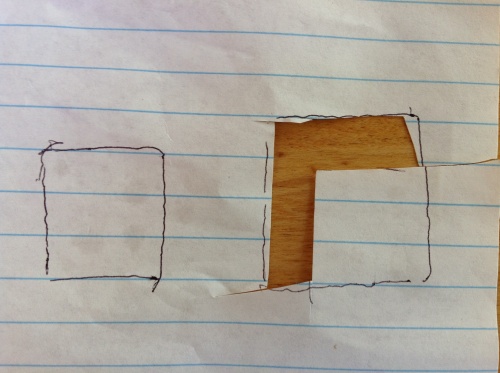There are now BIG Cheez-Its (U.S. only, it appears). The package claims that they are “Twice the size!” of regular Cheez-Its.

Naturally, I bought some a few months back.
I asked Tabitha (6 years old) and Griffin (8 years old at the time) what they thought. I started with Tabitha when Griffin wasn’t around so I could get her pure thoughts.
She put one cracker on top of the other and proclaimed, “No”.

I wanted to know why she thought that. I thought she might be mistaking side length for area. That is, maybe she was paying attention to the lengths of the sides of the two crackers rather than to the amount of cracker. So I asked about it.
She pointed to the uncovered part of the BIG Cheez-It and argued that this wasn’t enough to make another full regular Cheez-It. So she was paying attention to the amount of cracker.
A few minutes later, it was Griffin’s turn. He ran like a chipmunk with his two crackers into the dining room.
I imagined that this chipmunk would be nibbling the crackers next door and that our conversation would be at an end.
I was wrong.
He was in search of paper and a pen. He carefully traced each cracker, cut out the uncovered part of the BIG one and attempted to partition and reassemble this remainder on top of a tracing of the regular cracker, which it did not completely cover.
His conclusion: BIG Cheez-Its are almost but not quitetwice the size of the regular Cheez-Its.
So what do we learn?
Notice the differences between the children’s strategies. Tabitha, the six-year old, worked with the crackers. She put one cracker on top of the other and tried to picture whether the leftover space made up a whole cracker. She was very concrete in her thinking.
Griffin, the eight-year old, worked with representations of the crackers. He traced and cut out squares of paper which he could manipulate with more precision than the actual crackers.
The two children reached similar conclusions.
Neither child used tools to calculate areas.
Knowing whether one cracker is twice as big as the other does not require measuring how big either cracker is.
All of this is very typical for young children. Younger children tend to work with the actual things they are comparing. They are what we call concrete thinkers. Older children begin to work with representations of the things (e.g. Griffin’s cut outs). They are more likely to be abstract thinkers.
Starting the conversation
Investigate advertising claims. Have a healthy, skeptical attitude towards these claims, and encourage your children to wonder about them, too.
Be forewarned, though! You may create critical thinkers who question your authority, too.
And you may end up spending a LOT of time trying to figure out whether Double Stuf Oreos are really doubly stuffed.

